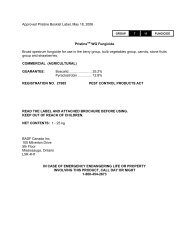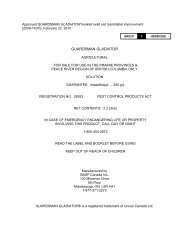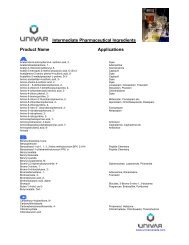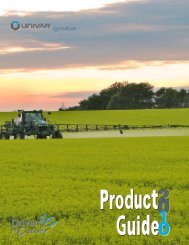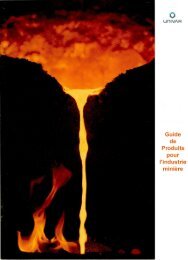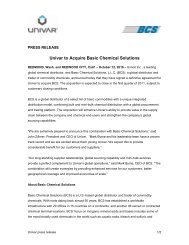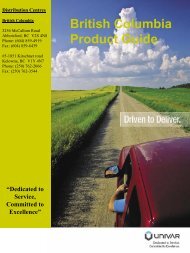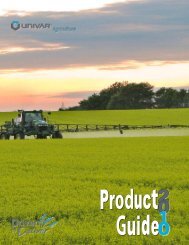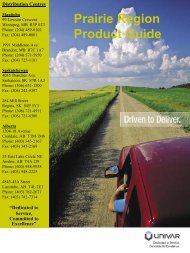Challenger Herbicide 2010 specimen.pdf - Univar Canada
Challenger Herbicide 2010 specimen.pdf - Univar Canada
Challenger Herbicide 2010 specimen.pdf - Univar Canada
Create successful ePaper yourself
Turn your PDF publications into a flip-book with our unique Google optimized e-Paper software.
<strong>Challenger</strong> TM <strong>Herbicide</strong>GROUP1HERBICIDEA SUSPENSION CONCENTRATE HERBICIDE FOR POST EMERGENCE CONTROL OF ANNUALGRASSES IN SMALL GRAIN CEREALS AND IN SELECTED FORAGE GRASSES GROWN FOR SEEDONLY.AGRICULTURALREAD THE LABEL AND ATTACHED BOOKLET BEFORE USINGKEEP OUT OF REACH OF CHILDRENGUARANTEE: Tralkoxydim ...........................400 grams per litreContains 1,2-benzisothiazolin-3-one at 0.025 % as a preservative.LiquidREGISTRATION NO. 29617 PEST CONTROL PRODUCTS ACTCAUTION: SKIN AND EYE IRRITANTNET CONTENTS: 4 L - bulkDow AgroSciences <strong>Canada</strong> Inc.Suite 2100, 450 - 1 Street S.W.Calgary, AlbertaT2P 5H11-800-667-3852Trademark of Dow AgroSciences LLC<strong>Challenger</strong> <strong>Herbicide</strong> E 29617 Feb10f <strong>specimen</strong>.doc page 1
PRECAUTIONSKEEP OUT OF REACH OF CHILDREN.Harmful if swallowed. May cause skin and eye irritation. Do not get on skin or in eyes. Do not wearcontact lenses when using chemicals. DO NOT ingest. DO NOT get on skin, clothing, or in eyes. Do notsmoke, eat, or drink while using this product.Wear chemically resistant gloves (nitrile), safety goggles, boots and coveralls when mixing, loading, andduring clean up or when adjusting or repairing sprayer. Wash gloves thoroughly with water beforeremoving them during any operation.Wash hands thoroughly with soap and water after using the product and before eating, drinking orsmoking.Do not contaminate food, water supplies or animal feed.If this pest control product is to be used on a commodity that may be exported to the U.S. and you requireinformation on acceptable residue levels in the U.S., visit CropLife <strong>Canada</strong>’s web site at www.croplife.ca.FIRST AIDTake container, label or product name and Pest Control Product Registration Number with youwhen seeking medical attention.If swallowed: Call a poison control centre or doctor immediately for treatment advice. Have person sip aglass of water if able to swallow. Do not induce vomiting unless told to do so by a poison control centreor doctor. Do not give anything by mouth to an unconscious person.If on skin or clothing: Take off contaminated clothing. Rinse skin immediately with plenty of water for15-20 minutes. Call a poison control centre or doctor for treatment advice.If inhaled: Move person to fresh air. If person is not breathing, call 911 or an ambulance, then giveartificial respiration, preferably by mouth-to-mouth, if possible. Call a poison control centre or doctor forfurther treatment advice.If in eyes: Hold eye open and rinse slowly and gently with water for 15-20 minutes. Remove contactlenses, if present, after the first 5 minutes, then continue rinsing eye. Call a poison control centre ordoctor for treatment advice.TOXICOLOGICAL INFORMATIONTreat symptomatically for ingestion and/or skin and eye contact. Symptoms are likely to be those of CNSdepression. Avoid respiratory depressants unless otherwise indicated.ENVIRONMENTAL PRECAUTIONSWhen applied by ground, do not apply within 15 m of non crop areas. When applied by air, do notapply within 50 m of non crop areas. Non crop areas include, fish-bearing waters, wetlands (potholes,sloughs etc.) and wildlife habitat (hedgerows, rights-of-way etc.). Avoid drift onto other crops and nontargetareas.For tank-mixes, consult the label(s) of the tank mix partner(s) and observe the largest (most restrictive)buffer zone of the products involved in the tank mixture.STORAGEStore in a cool, dry place, away from children, animals, food, feed or fertilizers. Keep unused product inresealed original container. Store above –5°C. Shake well before use.<strong>Challenger</strong> <strong>Herbicide</strong> E 29617 Feb10f <strong>specimen</strong>.doc page 2
SPILL CLEANUPWear appropriate protective equipment (gloves, glasses, apron) when attempting to clean up the spill. Ifthe container is leaking, secure leak and place the container into a drum or heavy gauge plastic bag.Contact Dow AgroSciences <strong>Canada</strong> Inc. for further information.For spills and leaks - contain the liquid with dikes of inert material (soil, clay, kitty litter etc.). Absorb thespill onto inert material and shovel into a sealable waste container.On hard surfaces - sprinkle spill area with detergent and scrub in a small quantity of water with a coarsebroom. Let stand 10 minutes then absorb onto an inert material and shovel into the waste container.On soil - remove the top 15 cm of soil in the spill area and replace with fresh soil. Dispose of all wasteincluding scrub brush in accordance with provincial requirements. Contact the manufacturer and theprovincial regulatory agency in case of a spill and for clean-up of spills.DISPOSALRecyclable Containers:Do not reuse this container for any purpose. This is a recyclable container, and is to be disposed of at acontainer collection site. Contact your local distributor/dealer or municipality for the location of thenearest collection site. Before taking the container to the collection site:1. Triple- or pressure-rinse the empty container. Add the rinsings to the spray mixture in the tank.2. Make the empty, rinsed container unsuitable for further use.If there is no container collection site in your area, dispose of the container in accordance with provincialrequirements.Refillable ContainersFor disposal, this container may be returned to the point of purchase (distributor/dealer). It must berefilled by the distributor/dealer with the same product. Do not reuse this container for any other purpose.For information on disposal of unused, unwanted product, contact the manufacturer or the provincialregulatory agency. Contact the manufacturer and the provincial regulatory agency in case of a spill, andfor clean-up of spills.PRODUCT INFORMATION<strong>Challenger</strong> <strong>Herbicide</strong> is a systemic, postemergence herbicide for the selective control of wild oats,volunteer tame oats, green foxtail, yellow foxtail, barnyard grass and Persian Darnel in spring wheat,durum wheat, winter wheat, barley, triticale, spring rye, winter rye, and selected forage grasses (exceptTimothy) grown for seed only.DIRECTIONS FOR USERates of UseApply <strong>Challenger</strong> <strong>Herbicide</strong> at 0.5 L/ha in 50-100 L/ha of water.Note: Always add Turbocharge® to the spray solution at a rate of 0.5 L per 100 L of water (0.5% v/v).The incorrect Turgocharge rate can result in unacceptable weed control or crop injury. See MIXING andSPRAYING INSTRUCTION sections.<strong>Challenger</strong> <strong>Herbicide</strong> E 29617 Feb10f <strong>specimen</strong>.doc page 3
<strong>Challenger</strong> <strong>Herbicide</strong> can be used on the following crops:CEREAL CROPS: (Spring Wheat, Durum Wheat, Winter Wheat, Barley, Triticale, Spring Rye and WinterRye) <strong>Challenger</strong> <strong>Herbicide</strong> can be used in all varieties of spring wheat (including <strong>Canada</strong> Western redspring, amber durum, soft white spring, extra strong and <strong>Canada</strong> prairie spring), red winter wheat, all 2 or6 row varieties of barley (malting and feed varieties), all varieties of triticale, spring rye and winter rye.Note: Tillered cereal crops may incur injury if applications are made within 48 hours of freezingtemperatures. Non-tillering cereal crops which are exposed to temperatures of 4°C or less up to 48 hoursbefore or after application may incur injury. Tank mixing <strong>Challenger</strong> <strong>Herbicide</strong> with a broadleaf weedherbicide under adverse conditions may increase severity of crop injury. Crops under stress from foliardiseases or low fertility are more susceptible to injury from <strong>Challenger</strong> <strong>Herbicide</strong>.Do not use in tame oat crops. Avoid drift onto tame oat and corn crops.Do not replant treated areas to tame oats or corn for at least 4 weeks after application.In Eastern <strong>Canada</strong> <strong>Challenger</strong> <strong>Herbicide</strong> is to be used only for the control of wild oats in spring wheat,winter wheat, durum wheat, barley and all varieties of triticale and spring and winter rye.Minimum Interval to HarvestImmature cereal crops may be grazed or cut for hay 16 days after treatment. Grain may be harvested 60days after treatment. Mature straw may be fed to livestock. Do not feed or graze underseeded foragecrops in the year of treatment, sufficient data are not available to support this use.CEREAL CROPS UNDERSEEDED TO FORAGE LEGUMES: alfalfa, birdsfoot trefoil, sainfoin andclovers.Note: Do not tank-mix <strong>Challenger</strong> <strong>Herbicide</strong> with any broadleaf herbicides when applying to cereal cropsunderseeded to forage legumes, as the forages may be injured or killed.WEEDS CONTROLLEDApply <strong>Challenger</strong> <strong>Herbicide</strong> to actively growing weeds for best results. Weeds emerging after applicationof <strong>Challenger</strong> <strong>Herbicide</strong> will not be controlled.CROP WEEDS CONTROLLED WEED GROWTH STAGE(ZADOKS or BBCH)WHEATDURUMBARLEYTRITICALERYEWILD OATS, VOLUNTEER OATSGREEN FOXTAIL, YELLOWFOXTAILBARNYARD GRASSPERSIAN DARNEL1-6 leaf(11,20 to 14,22)1-5 leaf(11,20 to 14,21)1-4 leaf(11 to 14)Optimum weed control and crop yield response occurs when grassy weeds are removed before theybegin to tiller. Refer to the illustration.<strong>Challenger</strong> <strong>Herbicide</strong> E 29617 Feb10f <strong>specimen</strong>.doc page 4
Weed Control Notes• Perennial grasses such as quack grass will not be controlled.• Susceptible grassy weeds treated with <strong>Challenger</strong> <strong>Herbicide</strong> cease growth soon after application,however, complete die-back of the weeds could take up to 2 weeks.• When grass weeds are stressed due to drought, heat, lack of fertility, flooding or prolonged cooltemperatures, control can be reduced or delayed since the grasses are not actively growing. Grassescapes or re-tillering may occur when application is made under prolonged stress conditions.Optimum weed control will be obtained if application of <strong>Challenger</strong> <strong>Herbicide</strong> is delayed until the stressconditions have ended and weeds are once again actively growing.• The herbicidal activity of <strong>Challenger</strong> <strong>Herbicide</strong> can be negatively affected if water containing highconcentrations (>400 ppm) of bicarbonate ions is used as a diluent. Water from deep wells is morelikely to contain high concentrations of bicarbonate ions. Ammonium sulfate at 9 to 18 kg per 1000litres of spray solution, can be used to counteract this antagonistic effect. Use only granular or liquidammonium sulfate formulations which do not contain additional wetters or surfactants.• <strong>Challenger</strong> <strong>Herbicide</strong> is not affected by rain falling one hour or more after application.TANK MIXES OF CHALLENGER HERBICIDE WITH BROADLEAF WEED HERBICIDES<strong>Challenger</strong> <strong>Herbicide</strong> alone will not control broadleaf weeds. For broad spectrum control of both annualgrasses and broadleaf weeds, <strong>Challenger</strong> <strong>Herbicide</strong> can be tank mixed with a variety of broadleaf weedherbicides. Refer to the following table for details and additional guidance. Read the appropriatebroadleaf herbicide label for information on broadleaf weeds controlled.Tank Mixing Notes• Read and strictly adhere to the use directions and precautions on the label of the product(s) that is/arebeing tank mixed with <strong>Challenger</strong> <strong>Herbicide</strong>. Also note all environmental restrictions and guidancesuch as rain fastness and maximum spraying temperatures on the label of the other product(s) beingtank mixed.• Do not tank mix with amine formulations of 2,4-D or with amine formulations of MCPA or with anyother herbicide, insecticide, fungicide, fertilizer solution or adjuvant not recommended on the label aspoor grass control and/or unacceptable crop injury may result.• With reduced water volumes, tank mixes with Buctril M, Thumper or Pardner may result in some initialinjury in the form of "tip burn". This injury, however, will not have any adverse effect on crop maturityor yield.• Do not tank mix <strong>Challenger</strong> <strong>Herbicide</strong> with broadleaf herbicides when applying to cereal cropsunderseeded to forage legumes as the forages may be injured or killed.<strong>Challenger</strong> <strong>Herbicide</strong> E 29617 Feb10f <strong>specimen</strong>.doc page 5
• Tank mixes with Attain <strong>Herbicide</strong> Tank-Mix or Prestige <strong>Herbicide</strong> Tank-Mix may cause temporary cropinjury if applied before the 4-leaf stage, however, yield will not normally be affected. These tank mixesmay provide a lower level of wild oat control than <strong>Challenger</strong> <strong>Herbicide</strong> alone.• Temporary crop injury may occur with registered tank mixes, in particular 2,4-D Ester/dichlorpropproducts, under extreme weather conditions or when the crop is suffering from stress due toinadequate or abnormally high moisture levels, or extreme temperatures. Barley may be injured withtank mixes of 2,4-D Ester/dichlorprop and Buctril M plus MCPA.• <strong>Herbicide</strong>s not listed on this label for tank mixing with <strong>Challenger</strong> <strong>Herbicide</strong> may be applied separatelyin sequence. Always apply <strong>Challenger</strong> <strong>Herbicide</strong> first and allow at least 7 days after the application of<strong>Challenger</strong> <strong>Herbicide</strong> before applying the other herbicide. <strong>Herbicide</strong>s labelled for tank mixing with<strong>Challenger</strong> <strong>Herbicide</strong> may also be applied sequentially, either before or after application of <strong>Challenger</strong><strong>Herbicide</strong>.TANK MIXES OF CHALLENGER HERBICIDE WITH INSECTICIDES:<strong>Challenger</strong> <strong>Herbicide</strong> alone or in combination with Buctril M products or Pardner can be tank mixed withMatador120EC Emulsifiable Concentrate Insecticide or Decis Flowable for one pass weed and insectcontrol. Always add Matador 120EC Emulsifiable Concentrate Insecticide or Decis Flowable to the spraytank after the herbicides but before adding Turbocharge.FOR ALL TANK MIXES, USE 0.5 LITRES CHALLENGER HERBICIDE PER HECTAREPLUS THE FOLLOWING:MIXINGREMARKSPARTNERInfinityMaximum rate of 0.83 L/ha for control of common ragweed and suppression ofround-leaved mallow.Buctril MAdditional MCPA Ester may be added to this tank mix to improve control of certainbroadleaf weeds (i.e. hemp nettle, volunteer canola). Refer to the Buctril M label forrecommended MCPA Ester rates. A reduction in control of green foxtail may occurwith the tank-mix of Buctril M and additional MCPA Ester. Maximum rate of Buctril Mof 1 L/ha.Attain TMDo not apply prior to the 4 leaf stage of the crop as temporary crop injury couldoccur, particularly in spray overlaps. Attain A 0.45 - 0.6 L/ha + Attain B 0.75 - 1.0L/ha rate range.Koril 324 Liquid Maximum rate of 1.2 L/ha<strong>Herbicide</strong>PardnerMaximum rate of 1 L/haApprove <strong>Herbicide</strong> Maximum rate of 1.24 L/haThumperMaximum rate of 1 L/haDichlorprop/2,4-D EsterMaximum rate of 1.75 L/ha (assuming 600 g dichlorprop/2,4-D Ester ai/L). Toensure optimum crop safety, do not apply prior to the 4 leaf stage of the crop as perthe dichlorprop/2,4-D Ester label timing.2,4-D Ester Maximum rate of 0.9 L/ha (assuming 600 g 2,4-D ai/L). Do not apply prior to the 4leaf stage of the crop as temporary crop injury could occur, particularly in sprayoverlaps.MCPA EsterLontrelTM +MCPA EsterMaximum rate of 930 mL/ha (assuming 600 g MCPA ai/L).Maximum rate of 0.28 L/ha + 1.12 L/ha (assuming 500 g MCPA ai/L). Apply between3 leaf expanded to before flag leaf of the crop. DO NOT apply after 6 leaf stage ofthe crop.<strong>Challenger</strong> <strong>Herbicide</strong> E 29617 Feb10f <strong>specimen</strong>.doc page 6
Curtail TM M<strong>Herbicide</strong>Prestige TM<strong>Herbicide</strong> Tank-MixMextrol 450MLiquid <strong>Herbicide</strong>Decis FlowableInsecticideTrophy TM<strong>Herbicide</strong> Tank-MixMatador 120ECEmulsifiableConcentrateInsecticideStarane TM<strong>Herbicide</strong>Apply between 3 leaf expanded to before flag leaf of the crop. DO NOT apply after 6leaf stage of the crop. Rate range of 1.5 - 2 L/ha.For use on spring barley, durum wheat and spring wheat only. Apply postemergence when weeds are in the seedling stage (2- to 4-leaf) and when springwheat and spring barley are in the 3-leaf to just before the flag-leaf emergencestage. Do not apply later than the flag-leaf emergence stage. Prestige A 0.6 - 0.8L/ha + Prestige B 1.5 - 2.0 L/ha rate range. DO NOT APPLY BY AIR.1.25 L/ha for use on spring wheat, durum and barley onlyMaximum rate of 120 mL/ha.Apply post-emergence when weeds are in the seedling stage (2-4 leaf) and whenspring wheat, durum wheat and spring barley are in the 3-leaf to flag-leaf stage. Donot apply later than the flag-leaf stage. Trophy A Emulsifiable Concentrate <strong>Herbicide</strong>0.6 L/ha + Trophy B Emulsifiable Concentrate <strong>Herbicide</strong> 1.12 L/ha rates. DO NOTAPPLY BY AIRApply 63-83 mL/ha for control of grasshoppers.Apply 0.4 L/ha for control of cleavers (1-4 whorls). Apply 0.6 L/ha for control ofcleavers (1-4 whorls), kochia (2-8 leaf), volunteer flax (1-12 cm) and suppression ofstork’s bill (1-8 leaf). Apply 0.8 L/ha for control/suppression of aforementionedweeds plus control of round-leaved mallow (1-6 leaf), and suppression of chickweed(up to 8 cm), hempnettle (2-6 leaf) and wild buckwheat (1-4 leaf).MIXING INSTRUCTIONSFollow the mixing instructions below for adding <strong>Challenger</strong> <strong>Herbicide</strong> to the spray tank.1. Only use sprayers in good running condition with high agitation. Ensure the sprayer and pre-mix tankis cleaned according to instructions on label of the product used prior to <strong>Challenger</strong> <strong>Herbicide</strong>. Useonly clean water for the spray solution. Ensure that all in-line strainer and nozzle screens in thesprayer are 50 mesh or coarser. Screens of 80 mesh size or finer should not be used.2. Begin to fill sprayer tank or premix tank with clean water, and engage agitator. Agitation must becontinued throughout the entire mixing and spraying procedure.3. When the sprayer or premix tank is three quarters full of water, add <strong>Challenger</strong> <strong>Herbicide</strong>. If morethan 1 case of <strong>Challenger</strong> <strong>Herbicide</strong> is to be used, add the <strong>Challenger</strong> <strong>Herbicide</strong> from all cases priorto adding tank mixed products or Turbocharge.4. If tank mixing, add the recommended product(s) next.5. Lastly, add Turbocharge, and then continue to fill tank to desired level with water.GROUND SPRAYING INSTRUCTIONS1. Apply in a spray volume of 50-100 L/ha at a pressure of 275 kPa to ensure proper dispersion,spraying characteristics and performance of <strong>Challenger</strong> <strong>Herbicide</strong>.2. Flat fan nozzles of 80 o or 110 o are recommended for optimum coverage. Do not use floodjet nozzlesor controlled droplet application equipment. Nozzles may be angled forward 45 o to enhancepenetration of the crop and provide better coverage. Ensure that all in-line strainer and nozzlescreens in the sprayer are 50 mesh or coarser. Screens of 80 mesh or finer should not be used.<strong>Challenger</strong> <strong>Herbicide</strong> E 29617 Feb10f <strong>specimen</strong>.doc page 7
3. Always ensure that agitation is continued until spraying is completed, even if stopped for brief periodsof time. If the agitation is stopped for more than 5 minutes, re-suspend the spray solution byrunning on full agitation prior to spraying. Do not begin spraying until fully re-suspended.<strong>Challenger</strong> <strong>Herbicide</strong> must be sprayed within the same day of mixing.4. When spraying is completed and prior to using other products, ensure the sprayer tank is thoroughlyrinsed with clean water to remove any remaining <strong>Challenger</strong> <strong>Herbicide</strong> residues. Using a pressurewasher and the addition of a detergent or Agral® 90 to the rinse water will enhance removal ofresidues.AERIAL APPLICATIONGeneric Aerial Application Label Instructions - Directions for UseApply only by fixed-wing or rotary aircraft equipment which has been functionally and operationallycalibrated for the atmospheric conditions of the area and the application rates and conditions of this label.Label rates, conditions and precautions are product specific. Read and understand the entire label beforeopening this product. Apply only at the rate recommended for aerial application on this label. Where norate for aerial application appears for the specific use, this product cannot be applied by any type of aerialequipment.Ensure uniform application. To avoid streaked, uneven or overlapped application, use appropriatemarking devices.Use PrecautionsApply only when meteorological conditions at the treatment site allow for complete and even cropcoverage. Apply only under conditions of good practice specific to aerial application as outlined in theNational Aerial Pesticide Application Manual, developed by the Federal/Provincial/Territorial Committeeon Pest Management and Pesticides.Do not apply to any body of water. Avoid drifting of spray onto any body of water or other non-targetareas. Specified buffer zones should be observed.Coarse sprays are less likely to drift, therefore, avoid combinations of pressure and nozzle type that willresult in fine particles (mist). Do not apply during periods of dead calm or when wind velocity anddirection pose a risk of spray drift. Do not spray when the wind is blowing towards a nearby sensitivecrop, garden, terrestrial habitat (such as shelter-belt) or aquatic habitat.Operator PrecautionsDo not allow the pilot to mix chemicals to be loaded onto the aircraft. Loading of premixed chemicals witha closed system is permitted.It is desirable that the pilot have communication capabilities at each treatment site at the time ofapplication.The field crew and the mixer/loaders must wear chemical resistant gloves, coveralls and goggles or faceshield during mixing/loading, cleanup and repair. Follow the more stringent label precautions in caseswhere the operator precautions exceed the generic label recommendations on the existing ground boomlabel.All personnel on the job site must wash hands and face thoroughly before eating and drinking. Protectiveclothing, aircraft cockpit and vehicle cabs must be decontaminated regularly.<strong>Challenger</strong> <strong>Herbicide</strong> E 29617 Feb10f <strong>specimen</strong>.doc page 8
AERIAL SPRAYING INSTRUCTIONS1. Apply in a spray volume of 30 to 45 L/ha at a pressure of 140-275 kPa to ensure proper dispersion,spraying characteristics and performance of <strong>Challenger</strong> <strong>Herbicide</strong>.2. Flat fan nozzles of 80 o or 110 o are recommended for optimum coverage. Do not use floodjet nozzlesor controlled droplet application equipment. Ensure that all in-line strainer and nozzle screens in thesprayer are 50 mesh or coarser. Screens of 80 mesh size or finer should not be used.3. Always ensure that agitation is continued until spraying is completed, even if stopped for brief periodsof time. If the agitation is stopped for more than 5 minutes, re-suspend the spray solution byrunning on full agitation prior to spraying. <strong>Challenger</strong> <strong>Herbicide</strong> must be sprayed within thesame day of mixing.4. Do not apply <strong>Challenger</strong> <strong>Herbicide</strong> if the wind is more than 13 km/h. This will avoid spray drift ontonon-target areas.5. Do not spray <strong>Challenger</strong> <strong>Herbicide</strong> if tame oats are present in adjacent, downwind fields.6. When spraying is completed and prior to using other products, ensure the sprayer tank is thoroughlyrinsed with clean water to remove any remaining <strong>Challenger</strong> <strong>Herbicide</strong> residues. Using a pressurewasher and the addition of a detergent or Agral 90 to the rinse water will enhance removal ofresidues.7. DO NOT APPLY within 50 m of non-crop areas. This includes fish-bearing waters, wetlands(potholes, sloughs etc.) and wildlife habitat (hedgerows, rights of way, etc.).READ THE FOLLOWING BEFORE USING THIS PRODUCT FOR SPECIAL USE APPLICATIONS:NOTE TO USER: READ THE FOLLOWING BEFORE USING THIS PRODUCT FOR THE INDICATEDSPECIAL USE APPLICATIONS: The DIRECTIONS FOR USE for this product for the use(s) describedbelow were developed by persons other than Dow AgroSciences <strong>Canada</strong> Inc. and accepted forregistration by Health <strong>Canada</strong> under the User Requested Minor Use Label Expansion program. DowAgroSciences <strong>Canada</strong> Inc. itself makes no representation or warranty with respect to performance(efficacy) and/or crop tolerance (phytotoxicity) claims for this product when used on the crop(s) listedbelow.Accordingly, the User assumes all risks related to performance and crop tolerance arising, and agrees tohold Dow AgroSciences <strong>Canada</strong> Inc. harmless from any claims based on efficacy and/or phytotoxicity inconnection with the use(s) described on this label.Pest(s)DIRECTIONS FOR USEWild Oats, volunteer oats, green foxtail, yellow foxtail, Persian Darnel.Rate of applicationSite (Crop)0.5 L <strong>Challenger</strong> <strong>Herbicide</strong>/ ha in 50 - 100 L of water/ ha. Add Turbochargeat a rate of 0.5 L/100L water (0.5% v/v).For the following forage grasses grown for seed only:• Seedling and established intermediate and crested wheatgrass,creeping red fescue, meadow and smooth bromegrass eitherunderseeded to cereals or grown alone.• For establishment of northern wheatgrass, western wheatgrass andslender wheatgrass.<strong>Challenger</strong> <strong>Herbicide</strong> E 29617 Feb10f <strong>specimen</strong>.doc page 9
Application TimingPre-Harvest IntervalOTHERPrior to tillering of the weeds (< 4 leaf stage)NADO NOT APPLY BY AIRDo not feed or graze forage crops, sufficient data are not available tosupport this use.One application per season.CAUTIONS:Do not tank mix <strong>Challenger</strong> <strong>Herbicide</strong> with other herbicides, insecticides, fungicides, fertilizers,micronutrients or adjuvants other than those listed on this label, when applying to these forage grasses.Apply <strong>Challenger</strong> <strong>Herbicide</strong> prior to tillering of the weeds. Applications made after the weeds have tilleredmay result in unacceptable weed control due to poor crop competition compared to cereal crops. Cropinjury or slight yield reductions may be expected following treatment in the year of establishment, however,the injury is transient and the crop will recover the following year.Pest(s)DIRECTIONS FOR USEWild Oats, volunteer oats, green foxtail, yellow foxtail, Persian Darnel.Rate of application andSpray VolumeSite (Crop)Application TimingPre-Harvest IntervalOTHER0.5 L <strong>Challenger</strong> <strong>Herbicide</strong>/ ha in 50 - 100 L of water/ ha. Add Turbochargeat a rate of 0.5 L/100L water (0.5% v/v).For Perennial Cereal Rye grown in the year of crop establishmentPrior to tillering of the weeds(1-4 leaf, 1-5 leaf, 1-6 leaf depending on the species)16 daysDO NOT APPLY BY AIROne application per season.FOR USE IN THE PRAIRIE PROVINCES ONLYCAUTIONS:Do not tank mix <strong>Challenger</strong> <strong>Herbicide</strong> with other herbicides, insecticides, fungicides, fertilizers,micronutrients or adjuvants other than those listed on this label, when applying to these forage grasses.Apply <strong>Challenger</strong> <strong>Herbicide</strong> prior to tillering of the weeds. Applications made after the weeds have tilleredmay result in unacceptable weed control due to poor crop competition compared to cereal crops.Crop injury or slight yield reductions may be expected following treatment in the year of establishment,however, the injury is transient and the crop will recover the following year.RESISTANCE MANAGEMENT RECOMMENDATIONSFor resistance management, <strong>Challenger</strong> <strong>Herbicide</strong> is a Group 1 herbicide. Any weed population maycontain or develop plants naturally resistant to <strong>Challenger</strong> <strong>Herbicide</strong> and other Group 1 herbicides. Theresistant biotypes may dominate the weed population if these herbicides are used repeatedly in the samefield. Other resistance mechanisms that are not linked to site of action, but specific for individualchemicals, such as enhanced metabolism, may also exist. Appropriate resistance-managementstrategies should be followed.<strong>Challenger</strong> <strong>Herbicide</strong> E 29617 Feb10f <strong>specimen</strong>.doc page 10



